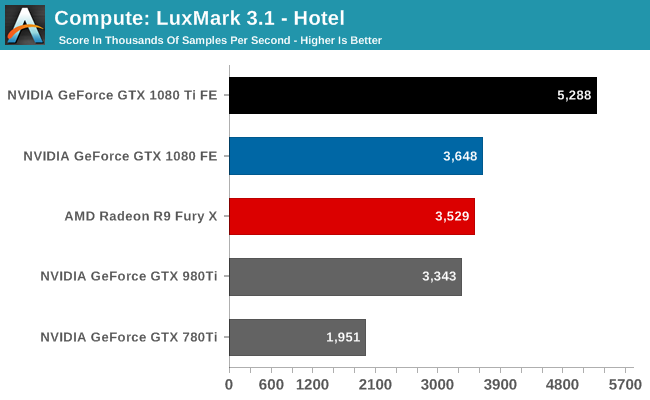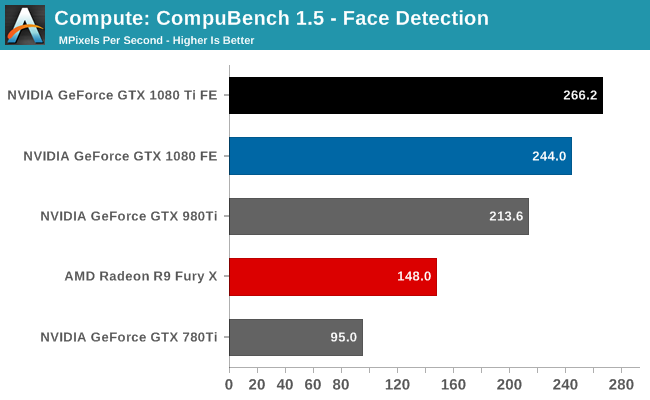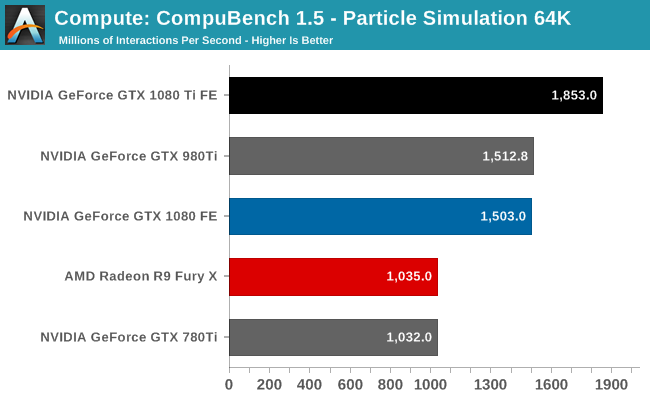The NVIDIA GeForce GTX 1080 Ti Founder's Edition Review: Bigger Pascal for Better Performance
by Ryan Smith on March 9, 2017 9:00 AM ESTCompute
Shifting gears, let’s take a look at compute performance on GTX 1080 Ti.
Starting us off for our look at compute is LuxMark3.1, the latest version of the official benchmark of LuxRender. LuxRender’s GPU-accelerated rendering mode is an OpenCL based ray tracer that forms a part of the larger LuxRender suite. Ray tracing has become a stronghold for GPUs in recent years as ray tracing maps well to GPU pipelines, allowing artists to render scenes much more quickly than with CPUs alone.

The OpenCL situation for NVIDIA right now is a bit weird. The company is in the middle of rolling out OpenCL 2.0 support to their video cards – something that I had actually given up hope on until it happened – and as a result their OpenCL drivers are in a state of flux as company continues to refine their updated driver. The end result is that OpenCL performance has dipped a bit compared to where the GTX 1080 launched at back in May, with said card dropping from 4138 points to 3648 points. Not that the GTX 1080 Ti is too fazed, mind you – it’s still king of the hill by a good degree – but the point is that once NVIDIA gets their drivers sorted out, there’s every reason to believe that NVIDIA can improve their OpenCL performance.
For our second set of compute benchmarks we have CompuBench 1.5, the successor to CLBenchmark. CompuBench offers a wide array of different practical compute workloads, and we’ve decided to focus on face detection, optical flow modeling, and particle simulations.



Like LuxMark, CompuBench shows some minor performance regressions on the GTX 1080 as compared to the card’s launch. None the less, this doesn’t do anything to impede the GTX 1080 Ti’s status as the fastest of the GeForce cards. It dominates every sub-benchmark, including Optical Flow, where the original GTX 1080 was unable to pull away from AMD’s last-generation Radeon R9 Fury X.










161 Comments
View All Comments
close - Monday, March 13, 2017 - link
I was talking about optimizing Nvidia's libraries. When you're using an SDK to develop a game you'er relying a lot on that SDK. And if that's exclusively optimized for one GPU/driver combination you're not going to develop an alternate engine that's also optimized for a completely different GPU/driver. And there's a limit to how much you can optimize for AMD when you're building a game using Nvidia SDK.Yes, the developer could go ahead and ignore any SDK out there (AMD or Nvidia) just so they're not lazy but that would only bring worse results equally spread across all types of GPUs, and longer development times (with the associated higher costs).
You have the documentation here:
https://docs.nvidia.com/gameworks/content/gamework...
AMD offers the same services technically but why would developers go for it? They're optimizing their game for just 25% of the market. Only now is AMD starting to push with the Bethesda partnership.
So to summarize:
-You cannot touch Nvidia's *libraries and code* to optimize them for AMD
-You are allowed to optimize your game for AMD without losing any kind of support from Nvidia but when you're basing it on Nvidia's SDK there's only so much you can do
-AMD doesn't really support developers much with this since optimizing a game based on Nvidia's SDK seems to be too much effort even for them, and AMD would rather have developers using the AMD libraries but...
-Developers don't really want to put in triple the effort to optimize for AMD also when they have only 20% market share compared to Nvidia's 80% (discrete GPUs)
-None of this is illegal, it's "just business" and the incentive for developers is already there: Nvidia has the better cards so people go for them, it's logical that developers will follow
eddman - Monday, March 13, 2017 - link
Again, most of those gameworks effects are CPU only. It does NOT matter at all what GPU you have.As for GPU-bound gameworks, they are limited to just a few in-game effects that can be DISABLED in the options menu.
The main code of the game is not gameworks related and the developer can optimize it for AMD. Is it clear now?
Sure, it sucks that GPU-bound gameworks effects cannot be optimized for AMD and I don't like it either, but they are limited to only a few cosmetic effects that do not have any effect on the main game.
eddman - Monday, March 13, 2017 - link
Not to mention that a lot of gameworks game do not use any GPU-bound effects at all. Only CPU.eddman - Monday, March 13, 2017 - link
Just one example: http://www.geforce.com/whats-new/articles/war-thun...Look for the word "CPU" in the article.
Meteor2 - Tuesday, March 14, 2017 - link
Get a room you two!MrSpadge - Thursday, March 9, 2017 - link
AMD demonstrated they "cache thing" (which seems to be tile based rendering, as in Maxwell and Pascal) to result in a 50% performance increase. So 20% IPC might be far too conservative. I wouldn't bet on a 50% clock speed increase, though. nVidia designed Pascal for high clocks, it's not just the process. AMD seems to intend the same, but can they get it similarly well? If so I'm inclined to ask "why did it take you so long"?FalcomPSX - Thursday, March 9, 2017 - link
I look forward to vega and seeing how much performance it brings, and i really hope it does end up giving performance around a 1080 level for typically lower and more reasonable AMD pricing, but honestly, i expect it to probably come close to but not quite match a 1070 in dx11, surpass it in dx12, and at a much lower price.Midwayman - Thursday, March 9, 2017 - link
Even if its just 2 polaris chips of performance you're past 1070 level. I think conservative is 1080 @ $400-450. Not that there won't be a cut down part at 1070 level, but I'd be really surprised if that is the full die version.Meteor2 - Tuesday, March 14, 2017 - link
I think that sometimes Volta is over-looked. Whatever Vega brings, I feel Volta is going to top it.AMD is catching up with Intel and Nvidia, but outside of mainstream GPUs and HEDT CPUs, they've not done it yet.
Meteor2 - Tuesday, March 14, 2017 - link
Mind you Volta is only coming to Tesla this year, and not consumer until next year. Do AMD should have a competitive full stack for a year. Good times!